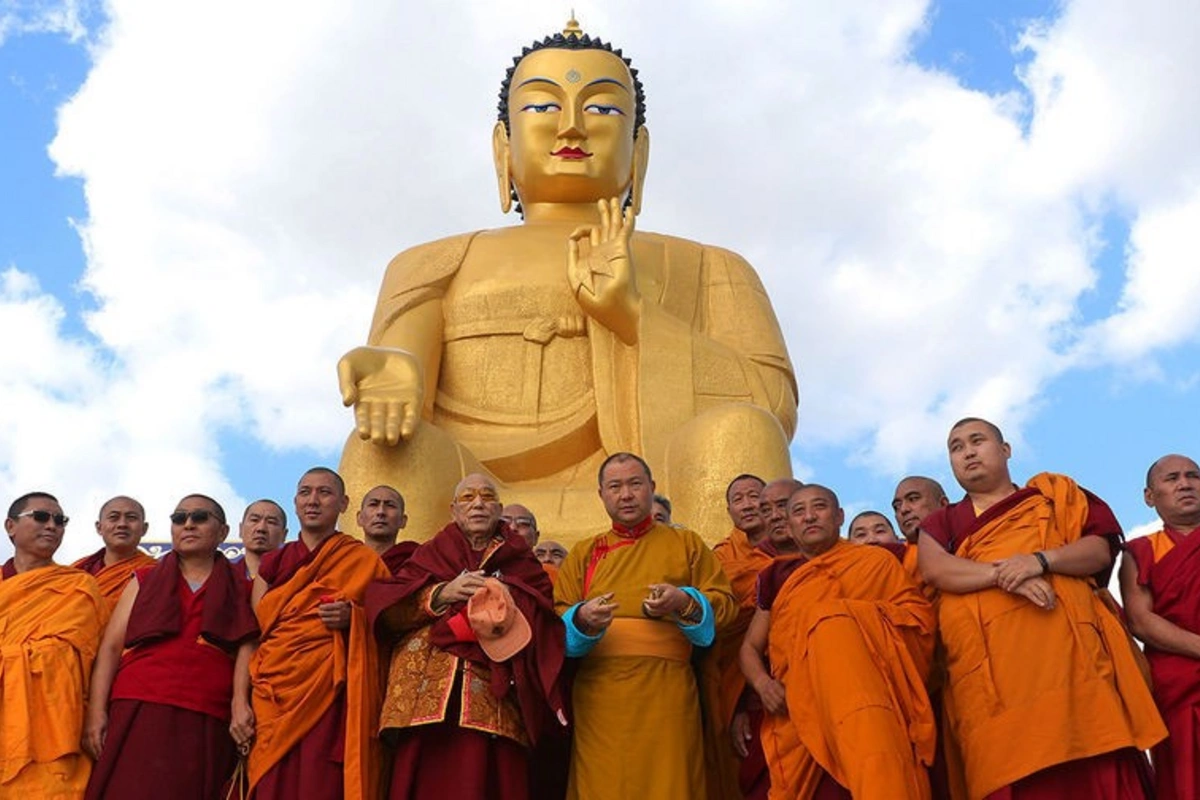
A prize-winning Caspian park design brings new attention to the wannabe port town, home to Europe’s biggest Buddhist statue. Welcome to Lagan – a little place with big dreams.
On September 22, 2019, monks from all across Kalmykia gathered in Lagan for the official ‘opening’ of the great Buddha statue outside the Dargyeling Khural temple. Image: Sanji Ubushiev/TASS
If you had to name all the republics bordering the Caspian Sea, the one you’d be most likely to miss would be Kalmykia. That’s not because the region lacks interest. On the contrary, as the only Buddhist republic in Europe, it should stand out as unforgettable. There’s also the fact that its one-time president was also head of the world chess federation for nearly 20 years, investing over US$50 million in Kalmykia’s ‘chess city.’ Or that the latest chief of the republic is a former kickboxer. However, Kalmykia is mostly steppe, its population (ethno-linguistically related to Mongolians) is sparse, and most of the coastline is relatively inaccessible.
Kalmykia’s one truly Caspian town is the modest settlement of Lagan (population around 13,000). Founded in 1870 by Russian settlers, Lagan was known as Kaspiyskiy from 1944 when it was liberated from German WW2 occupation. In 1991 it reverted to the original name that comes from a local Mongolian word meaning silt. Home to a Soviet fish plant after 1937, it was one of the key ports of the Volga-Caspian trawler fleet during the 20th-century before fish stocks declined in the 1990s. Then in 1997, with Caspian Sea levels at historic highs, the town was almost washed away: some damage remained unrepaired years after that. However, in the two decades that followed, the waters receded - so much so that today the former port town is some 9km inland, connected to the Caspian by the Laganski Canal.
Visitors in the past decade have reported a quaintly backward kind of place with scatterings of Siberian-style wooden cottages on quiet muddy streets. Till recently, there was still a pair of Lenin statues standing in the town centre, and the one minor attraction was the small local Buddhist monastery, known as Lagan Dargyeling Khural. However, in the last few years, Lagan has been on a drive towards conscious self-improvement. In September 2019, the town’s spiritual council unveiled a 30-tonne yellow-gold figure holding his hands in the vitarka mudra, a posture symbolizing debate or discussion of Buddhist teachings. At 12.5m tall, it’s Europe’s biggest Buddha statue.
Meanwhile, plans have been mooted for a massive investment that should utterly revive the town’s economic fortunes with the development of a big, multi-modal port. Many have expressed doubts as to the viability of a major container port in this relatively isolated place. However, with low waters reducing the viability of the Volga for larger ships and the decision to move Russia’s Caspian naval fleet from Astrakhan to Kaspysk (near Makhachkala, Dagestan), the need for a new logistics base in Russia’s North Caspian region is growing. News reports in August 2020 suggested that the plan had received federal approval from the Russian government but noted that investors were still required. That’s no small detail given the vast amount of work needed. However, it has added to a general sense of cautious optimism.
On a much more modest scale, this is apparent in the planned creation of the Melodiya Caspian Park, designed to emotionally and physically reconnect the town and the sea. Though as yet still on the drawing board, at the end of August 2021, the plan for this new recreational redevelopment was declared a winner of the all-Russia "Environment for Life: City and Water" competition. This should ensure funding for an envisaged new coastal zone complete with a lotus pond and a small pier. The idea is to finally make the most of Lagan’s potential to be Kalmykia’s nearest approximation to a seaside town.
Meanwhile, if you want to travel ‘virtually’ to Lagan, this interesting photo blog from 2015 sets the scene of how things were before the major new projects began, while this portrait of the town dates from 2019, just as the giant Buddha was nearing completion. Both are in Russian but the pictures speak for themselves.
Share on social media